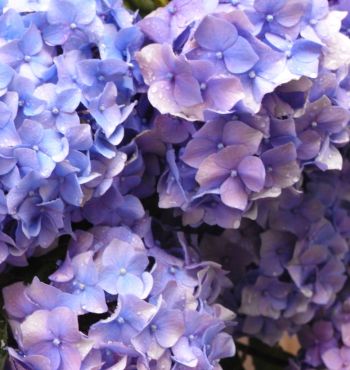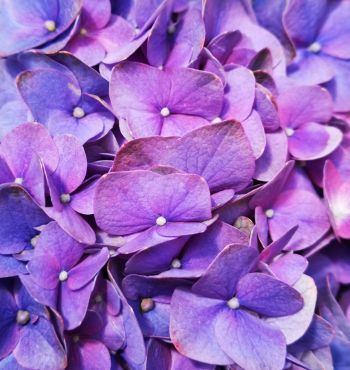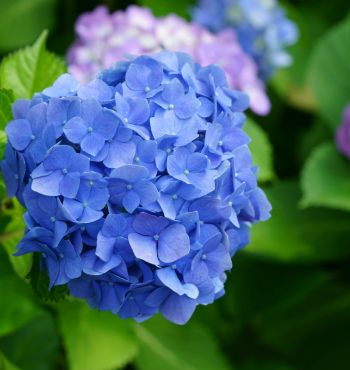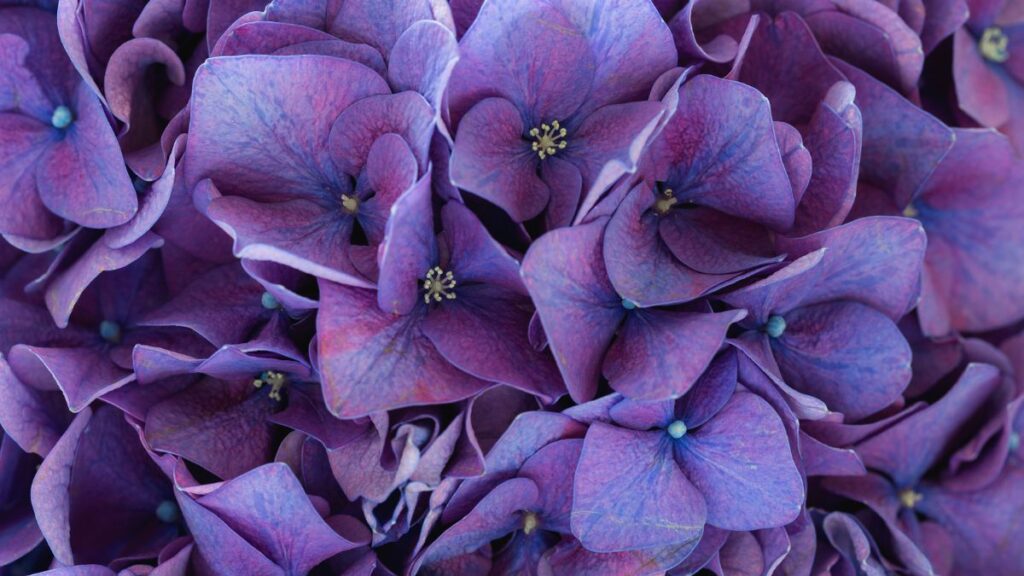In the enchanting world of gardens and blooms, one particular flower stands out with its mesmerizing charm—the purple hydrangea. With its lush petals painted in hues of lavender, violet, and royal purple, the purple hydrangea captivates hearts and sparks a sense of wonder. Nestled amidst verdant landscapes or gracing the edges of quaint cottages, this floral gem has become a symbol of grace and elegance.
The purple hydrangea, with its delicate clusters of blossoms, introduces a burst of color to any garden, creating a vibrant tapestry that catches the eye and ignites the imagination. Its name, derived from the Greek words “hydro” meaning water and “angeion” meaning vessel, hints at its affinity for moist soils—a testament to its adaptability and resilience.
As the seasons unfold, the purple hydrangea undergoes a captivating transformation, shifting its shades like a living kaleidoscope. From the first hints of spring to the warm embrace of summer and the crispness of autumn, each stage reveals a new facet of its beauty. Whether adorning a wedding bouquet or gracing a simple vase on a kitchen table, the purple hydrangea adds a touch of sophistication and natural allure to any setting.
Join us on a journey through the enchanting realm of the purple hydrangea, where each petal tells a story of timeless beauty and where the vibrant shades evoke a sense of tranquility and joy. In this floral symphony, the purple hydrangea takes center stage, inviting us to appreciate the simple yet profound wonders that nature graciously bestows upon us.
History and Origin
Purple hydrangeas, with their captivating hues, have a fascinating history rooted in diverse regions. Native to East Asia, particularly Japan, China, and Korea, these enchanting flowers thrived in the acidic soils of these lands. The journey of purple hydrangeas beyond their native habitats began when they captured the attention of plant enthusiasts.
In the early 18th century, these vibrant blooms were introduced to Europe by explorers and botanists fascinated by the exotic flora of the East. The captivating beauty of purple hydrangeas quickly gained popularity, leading to their cultivation in gardens across the continent. Their journey continued, and by the 19th century, purple hydrangeas found their way to North America, where they adapted to varying climates.
Culturally, purple hydrangeas hold symbolic significance. In Japan, they are associated with heartfelt emotion and gratitude, often used in ornamental arrangements during important ceremonies. In European cultures, these flowers symbolize abundance and prosperity, adorning gardens and events with their lush blooms. Over time, purple hydrangeas have become more than botanical wonders; they are intertwined with cultural and historical narratives, spreading their beauty and significance across the globe.
Types and Varieties

Purple hydrangeas come in a delightful array of types, each with its own unique charm for garden enthusiasts. Popular cultivars abound, offering a range of characteristics to suit different preferences.
One well-loved variety is the “Endless Summer,” known for its ability to bloom on both old and new wood, ensuring a continuous burst of purple hues throughout the growing season. “Nikko Blue” is another classic choice, showcasing large, rounded flower heads in vibrant shades of purple, creating a stunning visual impact.
The diversity of purple hydrangeas extends beyond cultivars to encompass an enchanting spectrum of shades. From deep, regal purples to softer lavender tones, these variations can significantly enhance the overall aesthetic appeal of any garden. The “Twist-n-Shout” cultivar, for example, boasts striking violet flowers that add a playful touch to the landscape.
Gardeners can strategically incorporate different shades of purple hydrangeas to create captivating color schemes. Lighter purples may evoke a sense of tranquility, while darker tones can contribute a touch of drama. Mixing cultivars like “Forever Pink” with its transitioning pink and purple blossoms can introduce a dynamic visual element.
Growing Conditions
Purple hydrangeas thrive best when planted in well-draining soil with a slightly acidic to neutral pH between 5.5 and 6.5. Choose a rich, loamy soil that retains moisture without becoming waterlogged. Incorporating organic matter, such as compost, into the soil enhances its texture and fertility.
Place your purple hydrangea in a location that receives partial to full sunlight. Morning sun is ideal, as it helps the plant to develop strong stems and promotes robust flowering. However, some afternoon shade can protect the plant from the intense midday sun, especially in warmer climates.
Proper watering is crucial for the health of purple hydrangeas. Keep the soil consistently moist but not soggy. Water the plants at the base to prevent fungal issues, and avoid wetting the foliage excessively. During hot and dry periods, increase watering frequency, ensuring the soil stays adequately hydrated.
To encourage healthy growth and vibrant blooms, provide a balanced fertilizer formulated for hydrangeas in the early spring. Apply the fertilizer according to package instructions, usually before new growth emerges. Mulching around the base of the plant helps retain moisture, suppress weeds, and regulate soil temperature.
Regularly inspect your purple hydrangea for pests and diseases, addressing any issues promptly. Prune the plants selectively in late winter or early spring to remove dead or weak stems and encourage new growth. This practice also helps shape the plant and enhances air circulation.
By following these simple guidelines for soil, sunlight, watering, and overall care, you can ensure your purple hydrangeas flourish, displaying their stunning blooms throughout the growing season.

Pruning and Maintenance
Pruning and maintaining purple hydrangeas is crucial for ensuring vibrant blooms and robust plant health. Regular care not only enhances the aesthetic appeal of your garden but also supports the overall well-being of these beautiful flowering shrubs.
Importance of Pruning
Pruning is essential for purple hydrangeas as it stimulates new growth, removes dead or damaged branches, and shapes the plant for an attractive form. This process encourages the development of more flowers and ensures adequate air circulation, preventing diseases.
Timing is Key
Prune purple hydrangeas during late winter or early spring before new growth emerges. This allows the plant to allocate energy efficiently for the upcoming blooming season.
Identify Dead Wood
Begin by inspecting the plant for dead or diseased wood. Using sharp pruning shears, carefully remove any lifeless branches at their base to promote healthier growth.
Selective Pruning
Focus on removing older, woodier stems to encourage the growth of new shoots. Trim back up to one-third of the oldest branches to stimulate fresh, vigorous growth and improve flower production.
Mindful Cuts
Make clean cuts just above a set of healthy buds or an outward-facing node. This promotes outward growth and prevents the plant from becoming too dense, allowing sunlight to reach inner branches.
Remove Spent Flowers
Deadhead faded blooms throughout the growing season to redirect energy towards new flower production. Snip the spent blooms just above the first set of healthy leaves or buds.
Mulching and Watering
After pruning, apply a layer of organic mulch around the base of the plant to retain moisture and regulate soil temperature. Water consistently to keep the soil evenly moist, especially during dry spells.
Common Pests and Diseases

Purple hydrangeas, like any other plants, can face common pests and diseases that may compromise their health. Aphids, small insects that suck sap from leaves, are a potential threat to purple hydrangeas. Keep an eye out for clusters of these pests, often found on the undersides of leaves.
Powdery mildew, a fungal disease, can affect purple hydrangeas, leading to a white powdery substance on the leaves. Adequate air circulation around the plant is crucial to prevent this issue. Ensure proper spacing and prune the hydrangea to enhance air flow.
Root rot poses another risk to purple hydrangeas, especially in poorly drained soil. Ensure the soil is well-draining and avoid overwatering, as excessive moisture can create conditions favorable for root rot.
Preventive measures are essential for maintaining the health of purple hydrangeas. Regularly inspect the leaves for aphids and promptly remove any infested parts. Encourage beneficial insects, like ladybugs, that naturally control aphid populations.
To prevent powdery mildew, maintain good air circulation by spacing hydrangeas adequately and trimming overgrown branches. Applying neem oil or a mixture of baking soda and water can serve as effective organic solutions.
For root rot prevention, plant purple hydrangeas in well-draining soil and ensure that containers have drainage holes. Water the plant at the base to minimize soil splashing onto leaves.
Using Purple Hydrangeas in Floral Arrangements
Purple hydrangeas, with their enchanting hues, bring a touch of sophistication to floral arrangements. Their versatility makes them ideal for a myriad of occasions and styles, adding an elegant charm to any setting.
For romantic occasions like weddings, purple hydrangeas can be incorporated into bouquets, creating a dreamy and enchanting atmosphere. Their rich color complements both traditional and modern wedding themes, making them a popular choice among brides and event planners.
In more casual settings, such as dinner parties or brunch gatherings, purple hydrangeas work seamlessly in centerpieces. Paired with other complementary flowers or arranged on their own, they effortlessly elevate the ambiance, turning an ordinary table into a stylish focal point. The simplicity of these blooms makes them adaptable to various decor styles, from rustic to contemporary.
When crafting bouquets, consider mixing purple hydrangeas with contrasting flowers to create a dynamic and visually appealing arrangement. Roses, lilies, or baby’s breath can complement the hydrangeas, enhancing their beauty. For a monochromatic look, a bouquet solely featuring purple hydrangeas radiates a sense of unity and elegance.
To maximize the longevity of your floral arrangements, ensure the purple hydrangeas are well-hydrated before assembling. Trim the stems at an angle and place them in water with floral preservative. Refresh the water regularly to maintain the blooms’ vibrancy.
Whether adorning a romantic wedding or gracing a casual brunch table, purple hydrangeas prove to be a versatile and charming choice for floral arrangements. With their timeless appeal and ability to enhance any setting, these blooms effortlessly weave elegance into every occasion.
Symbolism and Meaning
Purple hydrangeas hold rich symbolism and meaning across various cultures, transcending geographical boundaries. In many traditions, these exquisite flowers are revered as symbols of gratitude, understanding, and heartfelt emotions.
In Japanese culture, purple hydrangeas are associated with heartfelt apologies and sincere gratitude. The vibrant hue signifies an acknowledgment of one’s actions and a deep sense of appreciation. The delicate beauty of the purple hydrangea is believed to express understanding in a profound manner.
In Victorian times, the language of flowers, known as floriography, was a subtle way to convey emotions. Purple hydrangeas were utilized to express genuine heartfelt emotions, making them an ideal choice for conveying appreciation and understanding. The lush petals of the purple hydrangea were seen as a visual representation of the depth of emotions one wished to communicate.
Furthermore, in Korean culture, purple hydrangeas are linked to the concept of perseverance and the ability to endure challenges. This resilience is symbolized by the flower’s ability to thrive in various conditions, reflecting the strength needed to navigate life’s complexities.
Whether as a gesture of gratitude or a symbol of understanding, the purple hydrangea serves as a universal messenger of heartfelt emotions. Its vivid color and lush blooms create a visual language that speaks volumes, making it a cherished choice for those seeking to convey profound sentiments in a simple yet elegant manner.

Fun Facts and Interesting Trivia
Purple hydrangeas, with their vibrant hues, hold fascinating secrets that go beyond their stunning appearance. Did you know that these blossoms are not just a feast for the eyes, but also carry a special significance in the realm of anniversaries? Purple hydrangeas are linked with the 4th wedding anniversary, symbolizing enduring grace and beauty in a marital union.
What adds an extra layer of intrigue to these flowers is their ability to transform color like a botanical chameleon. This remarkable phenomenon is influenced by the soil’s pH levels. In acidic soils, purple hydrangeas tend to lean towards shades of blue, while in alkaline soils, they blossom into striking shades of pink. It’s like nature’s own magical art show, dictated by the very ground they call home.
But the color-changing prowess of purple hydrangeas doesn’t stop there. These flowers are also known for their responsiveness to aluminum in the soil. The presence of aluminum enhances the intensity of their color, making them even more mesmerizing.
Beyond their symbolic associations and color-changing abilities, purple hydrangeas have a rich history. Originating in Asia and brought to Europe in the 18th century, these flowers have since become popular worldwide for their elegance and versatility in gardens and floral arrangements.
FAQ for purple hydrangea
Is there a true purple hydrangea?
Yes, there is a true purple hydrangea. The color of hydrangea flowers is influenced by soil pH. In acidic soil, hydrangeas tend to appear blue, while alkaline soil produces pink flowers. However, there are specific hydrangea varieties, like the “Endless Summer” or “Pia,” that naturally bloom in shades of purple.
These hydrangeas have a genetic predisposition for the purple hue, irrespective of soil pH. So, if you’re aiming for a genuine purple hydrangea, selecting one of these varieties is the key. Remember, the magic lies not only in the soil but in the inherent characteristics of the hydrangea itself.
What does a purple hydrangea symbolize?
A purple hydrangea symbolizes enchantment and mystery. Its vibrant hue signifies wealth, abundance, and prosperity. This beautiful flower also represents grace and elegance, making it a perfect gift for expressing admiration or appreciation. The deep purple color of the hydrangea suggests a sense of calm and harmony, creating a soothing atmosphere.
Can you get purple hydrangeas?
Yes, you can get purple hydrangeas. To achieve this vibrant hue, consider the acidity of the soil. Acidic soil tends to produce blue or purple blooms, while alkaline soil results in pink or red flowers. Test your soil and, if needed, amend it with aluminum sulfate to increase acidity.
Are hydrangeas expensive?
Hydrangeas can be pricey, and influenced by factors like popularity, seasonal demand, and variety. Vibrant colors and high demand for events like weddings can drive up costs. Prices may vary by region and season, with peak times offering better deals. Check local florists for affordable options, and consider factors like plant size and health in determining the overall cost.
Conclusion
the enchanting purple hydrangea stands out for its captivating beauty, versatile nature, and rich cultural significance. Throughout this blog post, we’ve explored its vibrant hues, adaptable growth in various climates, and its role in symbolizing heartfelt emotions. These stunning flowers not only add a touch of elegance to gardens but also enhance floral arrangements with their striking presence.
Consider the purple hydrangea as more than just a plant—it’s a testament to the beauty found in nature. Its ability to thrive in diverse conditions makes it an excellent choice for any garden. Whether you’re a seasoned gardener or a budding enthusiast, the purple hydrangea offers an opportunity to elevate your outdoor space with its vivid colors.






